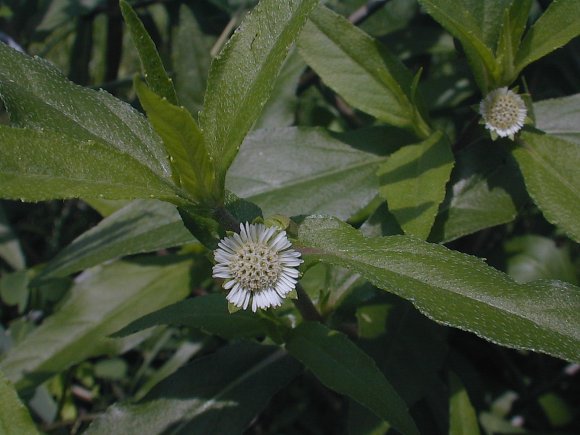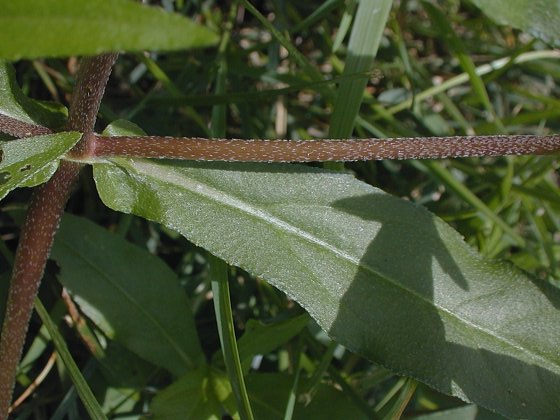Description: This plant is a summer annual in Illinois, while in areas with warmer climates it may be a short-lived perennial. It is about 1-2' long and has a tendency to sprawl along the ground in the absence of supportive vegetation. The reddish purple stems branch occasionally. They are round and have scattered white hairs that are appressed upward. The leaves are up to 5" long and 1" across. They are usually opposite, although some of the upper leaves may be alternate. The leaves are sessile against the stems, or they have short pedicels. Each leaf is more or less lanceolate, with scattered hairs that are appressed against the upper surface and a few blunt teeth along the margins. From the axils of the leaves, there are 1-3 flowerheads on short pedicels. Each flat-topped flowerhead is about 1/3" (8 mm.) across, consisting of about 8-16 bracts and numerous ray florets that surround the numerous disk florets. The spreading green bracts are triangular-shaped and form the base of the flowerhead. The ray florets are white and quite narrow and short, while the disk florets are cream or dull white with 4 small spreading lobes. Pale yellow or light brown anthers protrude slightly from the disk florets.

The blooming
period occurs from mid-summer until the fall, and lasts about 2-3
months. The flowerheads are not noticeably fragrant. As the achenes
develop in a flowerhead after the petals fall off, they are initially
green and cause the flowerhead to swell in size to about ½" across.
Each achene is oblong, truncate at the top, and tapering to
well-rounded tip at the bottom. Sometimes an achene may have 2 or 4
small teeth at the top. This plant can spread by forming rootlets at
the nodes of the leaves in muddy ground. It also reseeds itself, and
can form colonies at favorable sites.
Cultivation:
Full or partial sun, wet to mesic conditions, and a loamy or mucky soil
are preferred. Normally, this plant grows in rather wet habitats, but
it can also adapt to drier locations. Reniform nematodes occasionally
attack the roots. Like the tobacco plant, the foliage contains
nicotine, which is an insecticide.
Range & Habitat:
Yerba de Tajo is a common plant in southern and central Illinois, but
it is
uncommon or absent in northern Illinois. This plant is probably native
to southern and central Illinois, but adventive in the northern section
of the state (see
Distribution
Map); however opinions vary about this to some extent. Yerba
de Tajo has a world-wide distribution and can be
found in many Pacific Islands. It is a common weed in the American
tropics, but in some of the northern states of the U.S., such as
Wisconsin and New York, it is considered an endangered or threatened
native plant. In Illinois, habitats include poorly drained areas of
moist black soil prairies, muddy borders of ponds and rivers, ditches,
poorly drained areas in fields, gardens and edges of yards. This plant
is most often found in disturbed wetland habitats, but it occasionally
occurs in areas that are drier and more developed.

Faunal
Associations:
Very little information appears to be available about floral-faunal
relations for this plant. The flowerheads probably attract many of the
same kinds of insects as Asters, including small bees, flies, wasps,
small butterflies, and skippers, although such visitors appear to be
less common for Yerba de Tajo as its flowers are less showy and more
hidden in the foliage. This foliage is not considered toxic to deer and
other mammalian herbivores, assuming that it isn't eaten in enormous
quantities.
Photographic Location:
Along a fence at the edge of a lawn in Urbana, Illinois.
Comments:
Other common names are "False Daisy" and "Tattoo Plant." The latter
name refers to the fact that the juice of Yerba de Tajo can be used to
make blue tattoos. This plant is used in Chinese medicine and it has
been found to function as an antidote to the venom of rattlesnakes.
Apparently, when an aqueous solution of the plant juice is injected
into the affected muscle tissue, this reduces the hemorrhaging caused
by the venom. Yerba de Tajo resembles one of the white-flowered Aster
spp. (Asters), but its flowerheads have much shorter ray
florets and there is no tuft of hairs attached to each achene. The
flowerheads of Galinsoga spp. (Peruvian Daisies)
have short ray florets, but they are widely spaced and much fewer in
number than the ray florets of Yerba de Tajo.